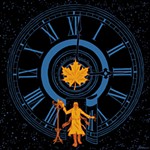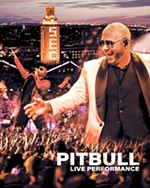Letters at 3AM
Mary's Monsters
By Michael Ventura, Fri., Oct. 19, 2001

In 1818, a year before the birth of Queen Victoria and 10 years before Edgar Allen Poe's first volume of poems, an English girl named Mary Shelley published Frankenstein. Her novel has been in print ever since. I found seven editions in one bookstore, the handsomest a Modern Library hardcover featuring a portrait of the author as haunting as the characters she created: an oval face, a strong Celtic nose, thin lips, and large eyes that stare in sorrow from her time to ours as though she sensed the horrors that would plague the future. She had reason to fear for us. She'd intuited the governing archetypes of the modern era: the scientist Victor Frankenstein, embodying the driven, fevered, ruthless creativity of the West; and his monster, the emblem of inventions that would prove uncontrollable and would spread confusion and terror.
Mary Shelley was born in 1797. Her father, William Godwin, was a political philosopher whose writings would influence both Karl Marx and the Anarchist movement. Her mother, Mary Wollstonecraft, wrote one of the earliest and most influential feminist treatises, A Vindication of the Rights of Women (1792). Wollstonecraft caught a fever during Mary's birth and died two weeks later. Mary grew up with a stepmother, a step- and a half-sister, and some of the finest minds of her time: Coleridge read his Rime of the Ancient Mariner in her living room while she was still a child; two inventors of the modern essay, William Hazlitt and Charles Lamb, were frequent guests, as was her father's young friend and associate, the poet Percy Bysshe Shelley. In 1814, when Mary was 16 and Shelley 22, they fell in love and eloped to France.
Their lives were chaos itself. Shelley was involved with several other women, including Mary's stepsister Claire (who'd gone with them to France). Mary had at least one affair that year -- and Shelley cheered her on. Mary's first child died two weeks after its birth in 1815. The spring of 1816 found Mary, Percy, their newborn second child William, and, yes, Claire, living together near Lake Geneva, where they were neighbors of the poet Lord Byron, who then also had an affair with Claire, who would bear his child. Frankenstein began one night when Mary, Shelley, and Byron, challenged each other to write ghost stories. Obsessed with the challenge, she had a frightening dream, which became the germ of her story. She was 18. She was 19 when she completed Frankenstein -- a year of writing in which she experienced another difficult pregnancy, the suicide of her half-sister Fanny, and the suicide of another of her husband's (pregnant) lovers.
Mary Shelley mentioned only the ghost story contest in 1834, when she tried to "give a general answer to the question so very frequently asked me -- how I, then a young girl, came to think of and to dilate upon so very hideous an idea." By 1834, her second child, William, and her third, Clara, had died. She'd given birth to a son, Percy, the only one of her children who lived to be an adult. She'd had a miscarriage. Her husband Shelley had drowned. She, Byron, the poet Leigh Hunt, and a friend named Trelawny, had burned Shelley's body on a beach in Italy. Trelawny had permanently damaged his hand by reaching into the fire and grabbing Shelley's heart, which he gave to Mary, and which Mary is said to have carried in her purse for the rest of her life. No, her 1834 account spoke merely of an evening when she and Shelley and Bryon innocently wondered about ghost stories, and that this had caused a nightmare. Only one clause hints at her true state: "I was not confined by my own identity."
Nowadays we might phrase that a little differently: She had few boundaries, or at best her boundaries were porous in the extreme -- not necessarily a bad thing ("I was not confined"), but a common affliction of artists. The circumstances she found herself in, and contributed to, were crazy even by today's standards; we can only guess how they looked to the eyes of the early 19th century. But there's another way to view the period of her life that produced Frankenstein: The wild poetic genius of Shelley and Byron, whose poems in their day were as shocking as their lives ... the incredible recklessness of young Mary, who defied every convention and who'd absorbed since childhood the most adventurous ideas of her time, living a life that certainly produced more than one nightmare ... all that raw ricocheting psyche and lust of Mary, Percy, and Byron in one room, one connected life ... during a time when the ideas of Old Europe were cracking to bits and a new industrialism, a new science, and a new politics, were painfully birthing what would become our age ... all this met in the undeveloped (and never fully developed) genius of Mary Wollstonecraft Godwin Shelley to form a vision that explained the modern era to itself in terms it could neither accept nor escape.
No other modern writer has produced such an indelible novel at such a youthful age. It is not that Frankenstein is a great novel. Compelling from beginning to end, its first half rolls along feverishly and at times brilliantly; its second half is contrived and often ridiculous until brilliance asserts itself again at the end. Yet while not a great novel, it is a great and terrible metaphor.
The novel is nothing like the 1931 movie written by Robert Florey and directed brilliantly by James Whale, followed in 1935 by Whale's equally stunning Bride of Frankenstein. Whale highlighted Mary Shelley's vision, reinventing the story from beginning to end. The films leave us with her thought's core: that humanity's inventions will take on a behavior of their own, beyond their inventor's intention, and will menace us not because the invention is intrinsically evil but because we don't understand what we've made -- we don't comprehend its needs, can't measure its power, don't know how to relate to it; therefore, finally, it turns against us in fury.
Mary Shelley's novel concentrates far more on Frankenstein than on the creation he calls "the daemon." The nameless daemon is monstrous, but Victor Frankenstein is the true monster. Like the ideal of progress that animated her era and still drives ours, his idealism sees nothing but itself. His pride is in thinking that just because he can do this thing, he understands what he's doing -- which of course he doesn't. If he can conceive it, he thinks he can control it -- which of course he cannot. He thinks of himself as good, so he believes his creation will certainly be good -- but he doesn't guess the darkness within his own soul, and doesn't realize that he can't help but transmit that darkness into what he creates. His creation will reflect all that he doesn't know about himself.
In the novel there are no outlandish mad-scientist toys, no electrical storms, no castles, no hideous Igor. Victor works alone in a little room with bits and pieces of flesh. His moment of horror is when his creation suddenly lives: "I saw the dull yellow eye of the creature open." Too late, he realizes his horrible mistake. He runs and doesn't stop running for the rest of his life.
This creature is not the dull-witted, raging thing that Boris Karloff portrayed so tellingly. (Karloff was cast, producer Carl Laemmle said, because "his eyes mirrored the suffering we needed.") Mary Shelley's daemon is huge, repulsive, but intelligent. He becomes articulate, intellectual, and develops a cogent (though askew) critique of society. He is driven to revenge only when he realizes that he is utterly abandoned by his creator and rejected by the civilized. If he cannot share the world's joys, he'll act out its nightmares. Unable to get what he wants, he'll destroy all Frankenstein has. The daemon says, "I have murdered the lovely and the helpless. ... You hate me; but your abhorrence cannot equal that with which I regard myself. I shall ascend my funeral pile triumphantly, and exult in the agony of the torturing flames." He is, among other things, the first terrorist.
Victor Frankenstein's loved ones are presented in sweet 19th-century pastels -- which Mary Shelley knows are false. If their lives were really as enlightened and vigorous as they themselves claim, the daemon could not destroy them so easily. As Frankenstein's doomed Elizabeth says, "When falsehood can look so like the truth, who can assure themselves of certain happiness? I feel as if I were walking on the edge of a precipice, toward which thousands are crowding ..."
First the daemon pursues Frankenstein, but Frankenstein dies pursuing his daemon. Everything Victor loves is no more -- including, as he's come to realize, his ideas about himself.
A proud trust in the unassailable worth of our creations generated the world we now live in -- a world that our creations have made more dangerous than even Mary imagined. She tells us we have no right to illusions of innocence, for the danger is not alien; the danger originated in us. In her metaphor, it's made of our very body parts; its twisted thoughts are our own, carried to extreme. In the darkness of Mary Shelley's vision there is little respite. Only now and again, in the subtle and languid prose rhythms of her era, does she admit a possibility of even momentary transcendence. Toward the end, Victor narrates of he and Elizabeth, "we walked for a short time on the shore enjoying the transitory light." ![]()








